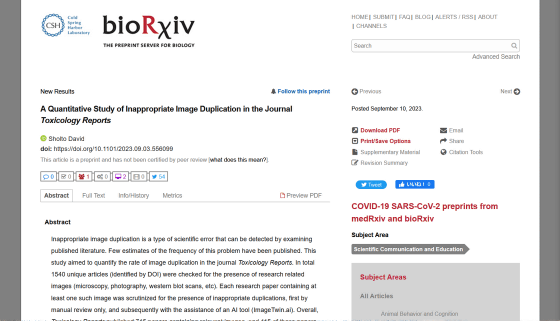Research results show that AI tools that detect ``unauthorized images'' in scientific papers are already more accurate than humans

The act of fraudulently manipulating images and data in scientific papers to falsify results is a serious problem that undermines trust in science in general, and efforts to detect fraud in papers are extremely important. A pre-peer review paper published on the preprint server bioRxiv shows that AI tools used to detect fraudulently manipulated images in scientific papers are already more accurate than human visual checks. It was reported in
A Quantitative Study of Inappropriate Image Duplication in the Journal Toxicology Reports | bioRxiv

AI beats human sleuth at finding problematic images in research papers
https://www.nature.com/articles/d41586-023-02920-y
In recent years, fraud in scientific papers has become a major issue, and in November 2022, several papers for which then-President Mark Teciela Bean of Stanford University was the lead author were found to have committed data manipulation and other fraud. It was reported that there is a possibility. Teciela Bean is a neuroscientist, and the papers under question include a highly influential paper on Alzheimer's disease.
Although there seems to be no evidence that Mr. Teciela Bean was personally involved in any misconduct or that he was aware of the misconduct of his co-researchers, Mr. Teciela Bean resigned from his post as university president in August 2023. I stepped back.
Stanford University president resigns due to fraudulent research papers, at least three papers to be retracted - GIGAZINE

In this way, it is not uncommon for scientific papers in which fraud was committed to pass peer review. In a 2016 study, American microbiologist Elizabeth Biku reported that after screening 20,621 papers, 782 papers had ``inappropriate image duplication.'' Although one-third of the 782 images may have simply been pasted incorrectly, half of them were clearly manipulated.
Who are the specialists who can spot fraudulent papers that reuse and manipulate images with the naked eye? -GIGAZINE

As these types of fraudulent scientific papers undermine the credibility of scientific research in general, it is becoming increasingly important to try to spot fraudulent papers. Therefore, biologist Sholto David , who is investigating fraudulent image manipulation in scientific papers, conducted a test to confirm the accuracy of Imagetwin , an AI tool that detects image manipulation in papers.
First, David investigated with his own eyes 715 papers containing related images that were published in Toxicology Reports , an academic journal of toxicology, from 2014 to 2023, and found that the images may have been manipulated. I have identified a paper. After that, he used Imagetwin to analyze the same group of papers and investigated what differences there were from his own research results.
As a result, Imagetwin not only investigated 2-3 times faster than David, but also discovered most of the 63 papers that David flagged and 41 papers that David overlooked. It was confirmed that it was possible.
David's paper has not yet been peer-reviewed, but a spokesperson for academic publisher Elsevier , which publishes Toxicology Reports, said: 'We are aware of this pre-peer-reviewed paper and have launched an internal investigation. I did,” he commented. Meanwhile, the editor-in-chief of Toxicology Reports responded that he had nothing to add to Elsevier's statement.

Imagetwin is an AI tool developed by ImageTwin AI, a company based in Vienna, Austria, and is used by about 200 universities, publishers, scientific organizations, etc. Mr. Bik, mentioned above, also uses Imagetwin as a tool to assist himself.
According to the developer, Imagetwin creates what can be called ``image fingerprints'' for all images included in a paper, and detects fraudulent manipulation by searching for images with duplicates of this fingerprint throughout the paper. It also checks against a database of approximately 25 million images published in other papers to check whether any images have been plagiarized from past papers. These processes take only 5 to 10 seconds, allowing them to scan large amounts of data faster than humans.
Yana Christopher, image integrity analyst at FEBS Press, the publishing platform of the Federation of European Biochemistry Societies (FEBS) , says, ``Sometimes we detect non-duplicates, or the software doesn't flag them. '', pointing out that AI tools such as Imagetwin have advantages and disadvantages. 'It's really great to have software as a second set of eyes,' he said, arguing that image manipulation checks that combine the human eye and AI tools should be incorporated into the paper review process.

Related Posts:





